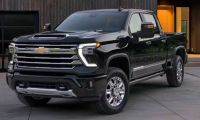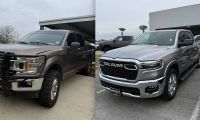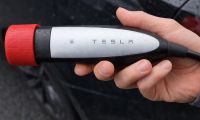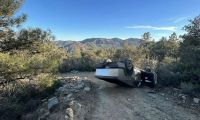One of the greatest frustrations of any repair is a repair that does not solve a problem…or at least solve it completely. Second to that frustration is when you hear a hum-like sound coming from your Toyota's front end, and the dealership garage either tells you they hear and feel nothing or says something like, "That's normal for a Toyota."
Common Toyota Tacoma, Tundra, and 4Runner Problem
According to a recent Royalty Auto Service YouTube channel episode, the Toyota Tacoma, Tundra, and 4Runner all share a common problem that sometimes confuses both mechanics and their customers―a constant or alternating hum with vibration that can be felt through the wheel or floorboard that manifests at particular speeds…and then goes away at a different speed.
Related article: Toyota Tacoma Problem That Will Give You the Shakes

This problem was addressed by the host with a previous repair on a 2015 Tacoma with front end issues that needed major front end repair. After the repairs were completed, the Tacoma operated significantly better; however, the owner noticed a slight hum-like sound with some vibration from the repaired Toyota's front end.
Looking a little deeper into what could be the cause of the noise, the host discovered this is a situation familiar to some years of Toyota models due to one of the most common modifications owners like to do with their Tacoma, Tundra, and 4Runners―put on bigger wheels with a lift kit.
At least one post comment supports this view of what can happen when Toyota owners DIY modify their vehicles:

In other words, you can expect problems to eventually develop when you change the geometry of the axle with the differential that affects the bearing between the two, which is why having your vehicle lifted is one of those jobs best left to a garage that specializes in ensuring that everything is aligned precisely right―especially with a vehicle that is going to see some off-road adventuring.
Follow along with the host as he shows how the hum-vibration was diagnosed and repaired on a 2015 Toyota Tacoma with 4WD. In the video, you will see the following:
- The importance of using a vibration analyzer to pinpoint a front-end problem.
- The recommended kit that replaces the problematic axle bearing with a bushing that is a permanent fix.
- How to remove the old bearing and seal and the tricks to doing it and not cause additional problems.
- How to install the replacement bushing and new oil seal.
- The results of a successful repair and retest for front-end vibration elimination.
Related article: This Is a Story That Breaks My Heart That a Very Good Toyota Rav4 Customer Had To Go Through
This Repair Fixes A Huge Issue With Lots Of Toyotas On The Road Today!
For additional articles related to Toyota repairs, check out these recommended articles:
- Toyota Tacoma Repair Scam… or Not?
- Toyota RAV4 Diagnosis and Fix You Can Do
- "Replace This Tensioner Pulley Now, or You Will Do It Later Anyway...When The Engine Blows" ―Toyota Warning
Timothy Boyer is an automotive reporter based in Cincinnati who currently researches and works on restoring older vehicles with engine modifications for improved performance. He also reports on modern cars (including EVs) with a focus on DIY mechanics, buying and using tools, and other related topical automotive repair news. Follow Tim on Twitter at @TimBoyerWrites as well as on Facebook and his automotive blog "Zen and the Art of DIY Car Repair" for useful daily news and topics related to new and used cars and trucks.
COMING UP NEXT: May I Know How Much Did You Pay For 2025 Toyota RAV4 Front-Wheel Drive Gas? ―The Toyota Models Car Dealers Are Gouging Buyers the Most On
Image Source: Deposit Photos













Comments
A well known phenomenon in…
Permalink
A well known phenomenon in the Vehicle design world. It is almost certainly caused by the design of the Vanes in the Alloy Road Wheels. At certain speeds the Wheels exhibit a humming/whining noise which can be heard by the driver.
I have read this can be…
Permalink
I have read this can be traced specifically to their 4wd front differential especially when turning wheel fully. A known ailment.
The number 1 cause of…
Permalink
The number 1 cause of problems: aftermarket parts and/or modifications. When I taught for GM, I was told numerous stories by senior FSEs (Factory Service Engineers) about all kinds of weird problems, many of these came in as Lemon Law complaints. OEM engineers go to great lengths to eliminate NVH issues. What is the best story I have heard yet? The Cadillac that died every other Tuesday at 2:00 pm. Catch me at a conference, and I'll gladly share that gem.
I agree. Aftermarket…
Permalink
In reply to The number 1 cause of… by Larry Elgenbrecht (not verified)
I agree. Aftermarket products can cause problems on their own and in the hands of someone not 100% clear on what is going on. I've read some shops specialize in ensuring the wheel-axle-trans geometry is correct for when owners want a lifted vehicle for show and for off-roading. Plus, they are in the know about the better aftermarket kits to use.
Thanks for pointing out that not all complaints are always justified as a Lemon Law complaint. I think that we tend to take too many complaints for granted sometimes.
Rotate the vehicle's tires…
Permalink
Rotate the vehicle's tires and see if it changes.
Pretty sure there is a T-sb…
Permalink
In reply to Rotate the vehicle's tires… by James Dunst (not verified)
Pretty sure there is a T-sb for this
Yep, that's is always a good…
Permalink
In reply to Rotate the vehicle's tires… by James Dunst (not verified)
Yep, that's is always a good first step when feeling frontend vibration or noise. I've missed tires that were developing separation issues too small to see that were the cause of some front end issues.
Thank you for the reminder.
Doesn't happen to my Prius :P
Permalink
Doesn't happen to my Prius :P
I've worked for Toyota for…
Permalink
I've worked for Toyota for 38 years. This problem occurs with lifted trucks and non lifted trucks. There is a TSB which covers this. Has been happening in Tacos since 05 , Tundras since 07, and 4 Runners since 10.
Does anyone know how much…
Permalink
Does anyone know how much this should cost to fix at a local Toyota dealership (ballpark)?